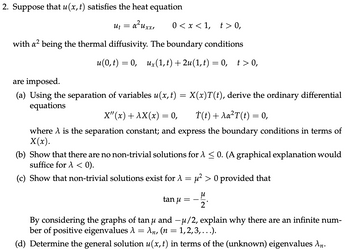
Advanced Engineering Mathematics
10th Edition
ISBN: 9780470458365
Author: Erwin Kreyszig
Publisher: Wiley, John & Sons, Incorporated
expand_more
expand_more
format_list_bulleted
Question

Transcribed Image Text:2. Suppose that u(x, t) satisfies the heat equation
Ut
= α²
a²uxx, 0<x<1, t>0,
with a² being the thermal diffusivity. The boundary conditions
u(0, t) = 0, ux(1, t) +2u(1, t) = 0, t> 0,
are imposed.
(a) Using the separation of variables u(x, t) = X(x)T(t), derive the ordinary differential
equations
X"(x) + AX(x) = 0,
İ(t) + Aa²T (t) = 0,
where A is the separation constant; and express the boundary conditions in terms of
X(x).
(b) Show that there are no non-trivial solutions for A ≤ 0. (A graphical explanation would
suffice for A < 0).
(c) Show that non-trivial solutions exist for A
=
tan u
=
µ² > 0 provided that
μ
2
By considering the graphs of tan µ and —µ/2, explain why there are an infinite num-
ber of positive eigenvalues λ = An, (n = 1,2,3,...).
(d) Determine the general solution u(x, t) in terms of the (unknown) eigenvalues An.
Expert Solution
This question has been solved!
Explore an expertly crafted, step-by-step solution for a thorough understanding of key concepts.
This is a popular solution
Trending nowThis is a popular solution!
Step by stepSolved in 4 steps with 4 images

Knowledge Booster
Similar questions
- For the equation af = k at with boundary conditions f(x = 0, t) = f(x 1, t) 0, and initial condition f(x,t = 0) = x(1-x), determine the full solution.arrow_forwardH2. A particle of mass m moves in a straight line under the action of a conservative force F(x) with potential energy U(x) = x²e-*. (i) Calculate F(x) and find the two equilibrium points of the system (i.e., points xẻ such that F(x) = 0). Compute if the equilibria are stable (i.e., local minima of the potential energy: U" (xe) > 0) or unstable (i.e., local maxima of the potential energy: U"(xe) 0. Find the initial energy Eo of the particle. Using (ii), show that the particle reaches x = 2 only if vo > ŷ, with 8e-2 v= and in this case the particle's velocity in x = 2 is v(2): = (a) x = 0, vo=0 (b) x=2, vo = 0 (c) x = 0, vo= 0.5 (d) x = 0, vo = -0.5 (e) x = 0, vo=2 (f) x = 0, vo= -10. m 8e-2 v². m (iv) Assume the particle starts in xo =0 with positive initial velocity vo > ŷ. Use (ii) to find the expression for v(x) and find the terminal velocity of the particle as x → ∞. If the particle starts with negative initial velocity vo < 0, can it escape to x →→∞? (v) Assume m= 1, show that the…arrow_forwardGiven yı (t) = t and y2(t) = t satisfy the corresponding homogeneous equation of t'y" – 2y = 1 – 2t°, t > 0 Then the general solution to the nonhomogeneous equation can be written as y(t) = c1y1(t) + ©2Y2(t) + Yp(t). Use variation of parameters to find a particular solution yp(t). Y,(t) = Tip: Before you use the formula Y29(t) Yı9(t) JW(n, y2) Yp = - Y1 + y2 W (y1, Y2) the ODE should be in the form y'' + a(t)y' + b(t)y = g(t)arrow_forward
- Suppose f(x, y) = origin. fx(0,0) = sin(8x³+2y¹) 5x²+7y² 0, fy(0,0) = (Enter "DNE" if the derivative does not exist.) (x, y) ‡ (0, 0) (x, y) = (0,0). Find the partial derivatives of f at thearrow_forwardConsider the second order homogeneous equation: 2x°y" +3.xy' – y = 0, (x>0) (a) Verify that y, =xV² and y, =x' are solutions of the ODE. (b) Find the Wronskian, W(y,,y,). (c) Do y, and y, form a fundamental set of solutions for the given ODE? If so, state the general solution.arrow_forward
arrow_back_ios
arrow_forward_ios
Recommended textbooks for you
 Advanced Engineering MathematicsAdvanced MathISBN:9780470458365Author:Erwin KreyszigPublisher:Wiley, John & Sons, Incorporated
Advanced Engineering MathematicsAdvanced MathISBN:9780470458365Author:Erwin KreyszigPublisher:Wiley, John & Sons, Incorporated Numerical Methods for EngineersAdvanced MathISBN:9780073397924Author:Steven C. Chapra Dr., Raymond P. CanalePublisher:McGraw-Hill Education
Numerical Methods for EngineersAdvanced MathISBN:9780073397924Author:Steven C. Chapra Dr., Raymond P. CanalePublisher:McGraw-Hill Education Introductory Mathematics for Engineering Applicat...Advanced MathISBN:9781118141809Author:Nathan KlingbeilPublisher:WILEY
Introductory Mathematics for Engineering Applicat...Advanced MathISBN:9781118141809Author:Nathan KlingbeilPublisher:WILEY Mathematics For Machine TechnologyAdvanced MathISBN:9781337798310Author:Peterson, John.Publisher:Cengage Learning,
Mathematics For Machine TechnologyAdvanced MathISBN:9781337798310Author:Peterson, John.Publisher:Cengage Learning,


Advanced Engineering Mathematics
Advanced Math
ISBN:9780470458365
Author:Erwin Kreyszig
Publisher:Wiley, John & Sons, Incorporated

Numerical Methods for Engineers
Advanced Math
ISBN:9780073397924
Author:Steven C. Chapra Dr., Raymond P. Canale
Publisher:McGraw-Hill Education

Introductory Mathematics for Engineering Applicat...
Advanced Math
ISBN:9781118141809
Author:Nathan Klingbeil
Publisher:WILEY

Mathematics For Machine Technology
Advanced Math
ISBN:9781337798310
Author:Peterson, John.
Publisher:Cengage Learning,

